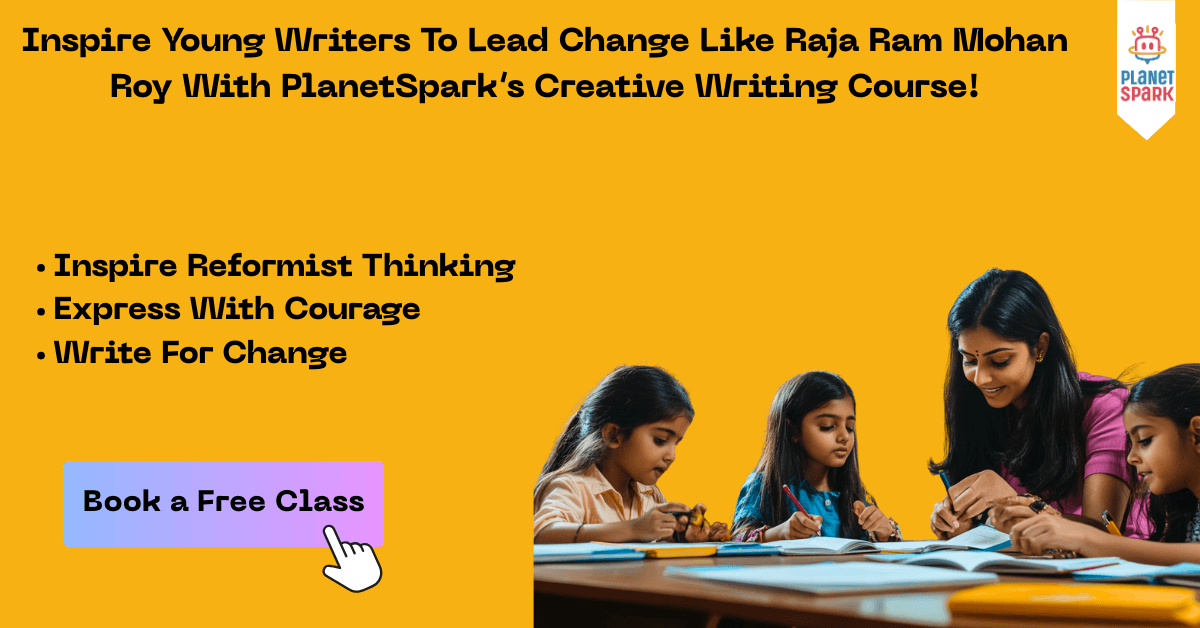Raja Ram Mohan Roy: Life, Reforms & Lasting Contributions

Table of Contents
- Early Life and Background
- Fight Against Sati and Social Reform
- Promotion of Women’s Rights
- Education and the Founding of Brahmo Samaj
- Raja Ram Mohan Roy and His Compatriots
- Influence Across Indian Regions
- Global Influence and Visit to England
- Legacy and Continuing Impact
- How PlanetSpark Supports the Spirit of Reform Through Educat
- Conclusion
- FAQs
Raja Ram Mohan Roy stands as one of the most influential social reformers in the history of modern India. A visionary far ahead of his time, he laid the foundation for numerous progressive changes in 19th-century Indian society, particularly in Bengal. His advocacy for women's rights, opposition to regressive traditions, and commitment to education and rational thought reshaped the social landscape of colonial India. In this blog, we will explore the life, work, legacy, and widespread influence of Raja Ram Mohan Roy, including the efforts of his key compatriots who supported his reformist vision.
At PlanetSpark, we believe in nurturing young minds to think critically, write creatively, and express ideas confidently—values that align closely with Raja Ram Mohan Roy’s emphasis on progressive education. Our Creative Writing Courses empower students to explore their imagination, build strong communication skills, and grow into articulate individuals—just like Roy envisioned for the new generation of Indians.
This blog explores the life and achievements of Raja Ram Mohan Roy, the people who supported his mission, and his far-reaching influence across India.
Early Life and Background
Raja Ram Mohan Roy was born on May 22, 1772, in Radhanagar, a village in the Hooghly district of Bengal. Born into a prosperous Brahmin family, he was introduced early to religious scriptures and traditional learning. However, unlike many of his peers, Roy displayed a deep curiosity for languages and cultures beyond India. He mastered Sanskrit, Persian, Arabic, and later learned English, Hebrew, Latin, and Greek.
His exposure to a variety of philosophies—Hindu Vedanta, Islamic Sufism, and Western Rationalism—helped shape his humanist and reformist worldview. He was particularly disturbed by certain social practices prevalent in Indian society, especially those that dehumanized women.
Fight Against Sati and Social Reform
One of the most significant contributions of Raja Ram Mohan Roy was his relentless crusade against the inhumane practice of sati (widow burning). The practice involved the burning of a widow on her husband’s funeral pyre, often under societal pressure or coercion. Roy, appalled by this tradition, began a vigorous campaign against sati.
He wrote articles, debated with orthodox Brahmins, and brought the matter to the attention of British administrators. His advocacy played a crucial role in influencing Lord William Bentinck, the then Governor-General of India, who passed the Bengal Sati Regulation in 1829, officially banning the practice.
Other Social Reforms
Roy’s reformist zeal extended beyond sati. He was a vocal critic of:
- Child marriage
- Polygamy
- Caste-based discrimination
- Idolatry and superstitions
He strongly believed that Indian society needed a moral and intellectual awakening and that religious practices should align with reason and ethical values.

Promotion of Women’s Rights
Raja Ram Mohan Roy was a pioneer in promoting women's rights in India. He emphasized:
1. Widow Remarriage
He advocated for the right of widows to remarry, which was considered taboo in orthodox Hindu society.
2. Education for Girls
He firmly believed that women's empowerment began with education. Roy worked towards establishing schools for girls and emphasized a curriculum that went beyond religious texts to include science, mathematics, and literature.
3. Property Rights for Women
Roy also fought for the inheritance rights of women, arguing that they should be treated equally under law and customs.
These initiatives laid the groundwork for future women’s rights movements in India.
Education and the Founding of Brahmo Samaj
Roy was a strong proponent of modern, secular education. In 1817, along with David Hare, he helped establish the Hindu College in Kolkata (now Presidency University), which became a center for Western learning in India.
In 1828, he founded the Brahmo Samaj, a socio-religious reform movement that aimed to purify Hinduism and promote monotheism, rational thinking, and social justice. The Brahmo Samaj became a critical platform for discussing and implementing progressive social policies, including women's education and inter-caste marriages.
Raja Ram Mohan Roy and His Compatriots
Raja Ram Mohan Roy was not alone in his quest for social transformation. Several contemporaries and allies played crucial roles in supporting his vision.
Dwarkanath Tagore
A wealthy zamindar and philanthropist, Dwarkanath Tagore, was one of Roy’s closest allies and a co-founder of the Brahmo Samaj. He provided financial backing for many of Roy’s reform initiatives and continued his legacy even after Roy’s death.
David Hare
A Scottish watchmaker turned educationist, David Hare, shared Roy’s belief in the power of modern education. Together, they founded schools and colleges that imparted Western-style education to Indian students. Hare’s contributions to the Hindu College were immense, and he remained a lifelong friend and collaborator of Roy.

Henry Derozio
Though younger, Henry Louis Vivian Derozio was influenced by Roy’s ideas and worked to instill rationalism and free thought among his students at Hindu College. His radical thinking and teachings laid the foundation for the Young Bengal Movement, which carried forward the spirit of reform and questioning orthodoxy.
Ram Chandra Vidyabagish
A scholar and educator, Vidyabagish was one of the earliest members of the Brahmo Samaj and edited the journal "Sambad Kaumudi," which Roy had founded. He helped disseminate reformist ideas to a wider audience.
Unlock your child's creative potential with PlanetSpark's Creative Writing Classes. Book a free trial session today and watch them grow into confident writers.
Influence Across Indian Regions
While Raja Ram Mohan Roy’s primary influence was in Bengal, his ideas had a ripple effect across various regions of India, inspiring social reformers and movements far beyond his immediate surroundings.
Maharashtra
In Maharashtra, reformers like Gopal Hari Deshmukh (Lokhitwadi), Mahadev Govind Ranade, and Jyotirao Phule were inspired by Roy’s advocacy for education and women's rights. Institutions such as the Prarthana Samaj (founded in 1867) mirrored the Brahmo Samaj and advocated social reform through rationalism and monotheism.
Punjab
In Punjab, leaders like Swami Dayananda Saraswati were influenced by the reformist climate Roy had helped create. The Arya Samaj, founded in 1875, while ideologically distinct from the Brahmo Samaj, also emphasized education, women’s rights, and the rejection of caste hierarchy.
South India
In South India, social reformers like Kandukuri Veeresalingam (Andhra Pradesh) were directly influenced by Roy’s work. Veeresalingam championed widow remarriage, women’s education, and social reform, mirroring the ideals of the Brahmo Samaj in the southern context.
Bihar and Odisha
Brahmo Samaj branches in Bihar and Odisha helped spread the message of social reform, secular education, and women’s empowerment, particularly among the emerging middle class in these regions.
Global Influence and Visit to England
Raja Ram Mohan Roy was also among the earliest Indians to travel to England. In 1830, he went as an ambassador of the Mughal Emperor Akbar II to petition the British Parliament for an increase in the emperor's pension. While in England, he interacted with British intellectuals, lawmakers, and reformers.
He was warmly received and recognized as a visionary thinker. Sadly, he died in Bristol in 1833, but his legacy continued to inspire generations of reformers in India and abroad.
Give your child the gift of expression. Join PlanetSpark’s free trial class and watch them craft powerful stories with confidence and creativity.
Legacy and Continuing Impact
Raja Ram Mohan Roy’s legacy is immense. He is often called the “Father of the Indian Renaissance” for initiating a new era of enlightenment and progress. His influence can be seen in:
- The abolition of sati and the advancement of women’s rights
- The rise of modern education in India
- The development of journalism and public opinion
- The strengthening of secular and rationalist ideals
- The foundation of reformist movements across India
Honours and Recognition
- The Government of India issued a postage stamp in his honour in 1964
- The Raja Ram Mohan Roy Library Foundation was established in 1972
- Numerous schools, colleges, and public institutions bear his name
- His contributions are part of India’s national curriculum
Creative expression starts with the right guidance. Enroll your child in a PlanetSpark free trial class to discover our engaging, expert-led writing sessions.
How PlanetSpark Supports the Spirit of Reform Through Education
Raja Ram Mohan Roy believed education was the key to enlightenment and progress. At PlanetSpark, we honor that legacy by offering world-class Creative Writing Courses that empower young minds to think critically, express ideas clearly, and become confident communicators.
Why Choose PlanetSpark’s Creative Writing Course?
- Live, Interactive Classes: Learn from top educators in real-time.
- Storytelling and Essay Writing: Master the art of structuring ideas.
- Grammar and Vocabulary: Build a strong language foundation.
- Confidence Building: Express thoughts without fear.
- Feedback-Driven Growth: Personalized feedback to improve writing skills.
Conclusion
Raja Ram Mohan Roy was more than a social reformer; he was a pioneer who envisioned an India rooted in reason, justice, and equality. Through his tireless efforts and with the support of his contemporaries, he challenged deep-rooted social evils and planted the seeds for a modern India. His legacy endures in the countless reform movements he inspired and the generations of Indians who continue to fight for education, equality, and empowerment.
Let us take inspiration from his life and contribute, in our own ways, to building a just and enlightened society.
Let your child’s words shape their future. Book a no-cost demo of PlanetSpark’s Creative Writing Course and help them build essential writing skills.
FAQs
1. Who was Raja Ram Mohan Roy?
Raja Ram Mohan Roy was an Indian social reformer known for his efforts to abolish the practice of Sati, promote women's rights, encourage education, and introduce modern, rational thought to Indian society.
2. What were the main reforms introduced by Raja Ram Mohan Roy?
He led movements to abolish Sati, promote widow remarriage, advocate for women's education, and fight against social evils such as child marriage, caste discrimination, and superstitions.
3. Who were some of Raja Ram Mohan Roy's contemporaries who supported his work?
Key allies included Dwarkanath Tagore, David Hare, Henry Derozio, and William Bentinck, all of whom played vital roles in supporting or complementing his reformist endeavors.
4. How did Raja Ram Mohan Roy influence other parts of India outside Bengal?
His ideas sparked reformist movements across regions like Maharashtra, Punjab, and South India, where leaders like Gopal Hari Deshmukh and Kandukuri Veeresalingam carried forward his progressive ideals.
5. What is PlanetSpark's Creative Writing Course?
PlanetSpark's Creative Writing Course is a live, interactive program designed to help children improve their writing skills, build vocabulary, explore storytelling, and learn to express thoughts effectively.
6. How does PlanetSpark’s course align with Raja Ram Mohan Roy’s educational ideals?
Just as Raja Ram Mohan Roy emphasized rational thinking and progressive education, PlanetSpark encourages critical thinking, creativity, and effective communication through its structured writing curriculum.
7. Who can enroll in PlanetSpark’s Creative Writing Course?
The course is designed for school-aged children (Grades 2–8) who wish to enhance their creative writing, narrative expression, and communication skills in a fun and engaging online environment.
Download Free Worksheets
Personalized Communication Report
Record a video to get a AI generated personalized communication report for your child

Hi There, want to try these
tips for your child with
LIVE with our expert coach?
Let's check your child's
English fluency

